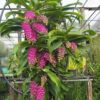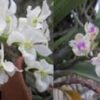# The Therapeutic Uses of Dendrobium Anosmum (Đai Châu Orchid) in Traditional Medicine

Dendrobium anosmum, commonly known as the Đai Châu orchid, is a flowering plant native to Southeast Asia, particularly Vietnam. Celebrated for its stunning beauty and fragrant blooms, this orchid holds a special place in traditional medicine. In this comprehensive exploration, we will delve into the therapeutic properties of Dendrobium anosmum, its applications in traditional medicine, the active compounds responsible for its medicinal effects, and its cultural significance. By the end of this article, you will gain a deeper appreciation for this remarkable orchid and its role in holistic health practices.
## 1. Overview of Dendrobium Anosmum
### 1.1 Botanical Characteristics
Dendrobium anosmum is an epiphytic orchid belonging to the family Orchidaceae. This perennial plant is characterized by its long, slender pseudobulbs, which can grow up to 60 cm in height, and its narrow, lanceolate leaves that alternate along the stems. The orchid produces clusters of beautiful, fragrant flowers that can range in color from lavender to purple, often with a waxy texture and a slightly ruffled appearance. The blooming season typically occurs in spring, attracting not only gardeners but also those interested in its medicinal properties.
### 1.2 Cultural Significance
In Vietnam and other Southeast Asian countries, Dendrobium anosmum is highly valued not only for its aesthetic appeal but also for its cultural symbolism. The orchid is often associated with love and affection, making it a popular choice for gifting on special occasions. Additionally, it holds a place in traditional rituals and ceremonies, where it is believed to bring good luck and prosperity.
## 2. Traditional Uses of Dendrobium Anosmum
### 2.1 Historical Background
The use of Dendrobium anosmum in traditional medicine dates back centuries. In many Asian cultures, orchids have been revered for their beauty and their perceived healing properties. Traditional healers and herbalists have long recognized the potential of Dendrobium species, including Dendrobium anosmum, in treating various ailments.
### 2.2 Medicinal Applications
The therapeutic applications of Dendrobium anosmum in traditional medicine are diverse. Below are some of the key uses:
#### 2.2.1 Respiratory Health
One of the primary uses of Dendrobium anosmum is in the treatment of respiratory conditions. The orchid is believed to have expectorant properties, helping to alleviate coughs and clear phlegm from the respiratory tract. Traditional preparations often include infusions or decoctions made from the dried flowers and stems, which are consumed to promote lung health and ease breathing difficulties.
#### 2.2.2 Immune System Support
Dendrobium anosmum is thought to possess immunomodulatory effects, helping to strengthen the immune system. This is particularly important in traditional medicine, where the focus is on promoting overall health and preventing illness. Regular consumption of orchid preparations is believed to enhance the body’s natural defenses against infections and diseases.
#### 2.2.3 Anti-Inflammatory Properties
The orchid’s anti-inflammatory properties make it beneficial for treating conditions associated with inflammation, such as arthritis and other joint-related issues. Herbalists often recommend Dendrobium anosmum as a natural remedy to reduce swelling and pain, particularly in the joints.
#### 2.2.4 Skin Health
Dendrobium anosmum is also used in traditional medicine for its skin health benefits. The orchid is thought to possess moisturizing and soothing properties, making it a popular ingredient in topical preparations for treating dry or irritated skin. Infusions or extracts made from the orchid can be applied externally to promote healing and rejuvenation.
#### 2.2.5 Stress and Anxiety Relief
The calming and soothing effects of Dendrobium anosmum extend to mental health as well. Traditional healers often use the orchid in herbal formulations to help alleviate symptoms of stress and anxiety. The aromatic properties of the flowers are believed to have a calming effect on the mind, promoting relaxation and emotional well-being.
## 3. Active Compounds in Dendrobium Anosmum
### 3.1 Phytochemical Composition
The therapeutic effects of Dendrobium anosmum can be attributed to its rich phytochemical composition. Various studies have identified several bioactive compounds present in the orchid, including alkaloids, flavonoids, glycosides, and phenolic compounds. These compounds contribute to the orchid’s medicinal properties and play a crucial role in its efficacy.
### 3.2 Key Bioactive Compounds
– **Alkaloids**: These compounds have been shown to possess analgesic and anti-inflammatory properties, making them beneficial for pain relief and inflammation reduction.
– **Flavonoids**: Known for their antioxidant effects, flavonoids help protect the body from oxidative stress and support overall health.
– **Glycosides**: These compounds contribute to the orchid’s immune-boosting properties and have been linked to improved respiratory function.
– **Phenolic Compounds**: With strong anti-inflammatory and antimicrobial effects, phenolic compounds support skin health and aid in wound healing.
## 4. Preparation and Usage
### 4.1 Traditional Preparations
Dendrobium anosmum can be prepared in various ways for medicinal use. Here are some common methods of preparation:
#### 4.1.1 Infusions
Infusions are one of the simplest ways to prepare Dendrobium anosmum for consumption. To make an infusion, follow these steps:
1. **Ingredients**: Gather dried flowers and stems of Dendrobium anosmum.
2. **Boiling Water**: Bring water to a boil.
3. **Steeping**: Add the dried orchid parts to a teapot or cup, then pour the boiling water over them.
4. **Cover**: Let the mixture steep for 10-15 minutes, covered to retain the aromatic compounds.
5. **Strain**: Strain the liquid into a cup and enjoy. You can sweeten it with honey if desired.
#### 4.1.2 Decoctions
Decoctions involve simmering the plant material in water to extract its medicinal properties. Here’s how to prepare a decoction:
1. **Ingredients**: Use dried flowers and stems of Dendrobium anosmum.
2. **Water**: Measure water in a pot (approximately 500 ml).
3. **Simmering**: Add the dried orchid parts to the pot and bring it to a gentle boil. Reduce the heat and let it simmer for 20-30 minutes.
4. **Cooling and Straining**: Remove from heat, allow it to cool slightly, then strain the liquid into a container.
#### 4.1.3 Topical Applications
For skin-related issues, extracts or infusions of Dendrobium anosmum can be used topically. Simply apply the cooled infusion or decoction to the affected areas for soothing relief.
### 4.2 Dosage and Safety
While Dendrobium anosmum is generally considered safe for consumption, it is essential to use it judiciously. Typical dosages for infusions or decoctions range from one to two cups per day. However, individuals with specific health conditions or those taking medications should consult with a healthcare professional before incorporating Dendrobium anosmum into their regimen.
## 5. Research and Scientific Validation
### 5.1 Traditional Knowledge vs. Modern Science
The traditional uses of Dendrobium anosmum have garnered attention from the scientific community, leading to various studies aimed at validating its medicinal properties. Research has focused on isolating and identifying bioactive compounds and investigating their therapeutic effects.
### 5.2 Clinical Studies
Preliminary studies have indicated that extracts from Dendrobium anosmum possess antioxidant, anti-inflammatory, and antimicrobial properties. While more extensive clinical trials are necessary to confirm these findings, the existing research provides a promising foundation for the therapeutic potential of this orchid.
## 6. The Cultural Importance of Dendrobium Anosmum
### 6.1 Symbolism in Vietnamese Culture
In Vietnamese culture, orchids, particularly Dendrobium anosmum, are symbols of beauty, love, and elegance. They are often used in floral arrangements for weddings, celebrations, and ceremonies, signifying purity and affection.
### 6.2 Integration into Traditional Practices
The integration of Dendrobium anosmum into traditional healing practices reflects a deep-rooted respect for nature and the belief in the healing power of plants. Healers and herbalists have passed down knowledge of the orchid’s uses through generations, highlighting its significance in the cultural heritage of Vietnam.
## 7. Conclusion
Dendrobium anosmum, or Đai Châu orchid, stands as a testament to the intersection of beauty and utility in nature. Its therapeutic applications in traditional medicine highlight the importance of preserving traditional knowledge and exploring the potential of natural remedies. While the orchid is admired for its stunning flowers, its role in promoting health and well-being cannot be overlooked.
As research continues to uncover the therapeutic benefits of Dendrobium anosmum, the orchid’s significance in traditional medicine is likely to gain further recognition. By embracing the healing properties of this remarkable plant, we can honor the wisdom of traditional practices while enhancing our understanding of natural health solutions.
In conclusion, whether you are an orchid enthusiast, a practitioner of traditional medicine, or simply someone interested in holistic health, Dendrobium anosmum offers a wealth of knowledge and therapeutic potential that deserves exploration and appreciation.

